Time for a guest post! Today, Laurie Latour speaks about Gingham Lace, which is also known as “chicken scratch embroidery,” among other names. In today’s article, Laurie shares with us some photos of beautiful pieces from her own collection and tells us a bit about stitching on gingham. Enjoy!
Lace and gingham – hmmmmmm…. not usually thought of together, especially not as an embroidery stitch. While it’s not real lace-making, lace stitch is a type of needle weaving worked on gingham that produces many lacy looks. It’s not difficult to do and works up quickly. Inexpensive gingham and floss are the only supplies needed, which is, no doubt, one reason it was especially popular during the Great Depression.
Depression Lace, Hoover Lace, Snowflake Lace, Amish Lace – it goes by many names. Let’s take a look at some pieces from my collection.
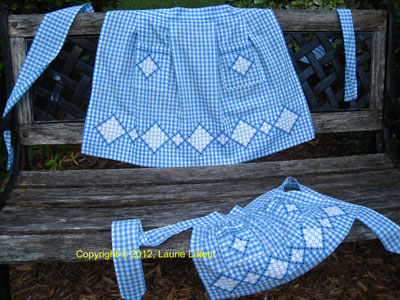
Traditionally, Lace Stitch is worked in white as we see in these sweet Mother-Daughter aprons. Vertical and horizontal rows of running stitches are worked on all sides of the white gingham checks. Floss or pearl cotton is woven under four stitches, encircling the white fabric checks. Double cross stitches, or snowflakes, fill the dark gingham checks, adding to the lacy appearance.
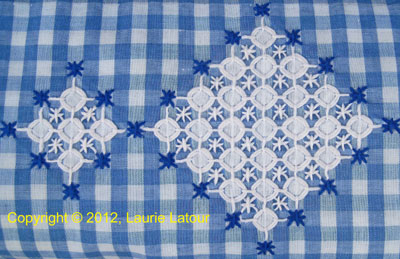
As with anything, there are many variations! Usually needle weaving is worked on quarter-inch checked gingham. Here it was stitched on eighth-inch checks. This needle worker chose not to use any snowflake stitches, allowing the blue gingham checks to stand out, drawing the eye down to the flowing lines in the drawn thread work – a lovely detail on this apron:
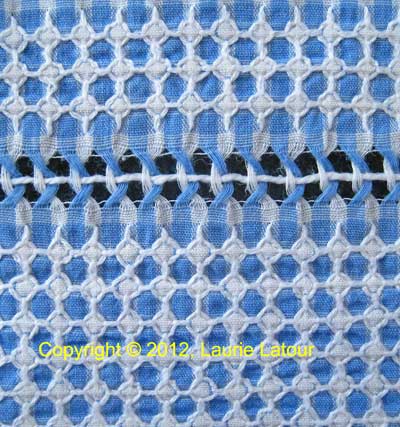
It’s always fun to experiment and depart from traditional white floss or floss that matches the color of the gingham. In fact, sometimes the embroidery is difficult to see, or appreciate, because it “fades” away into the gingham background. Not so in this apron below! The needle worker used a contrasting thread color to create a more prominent design.
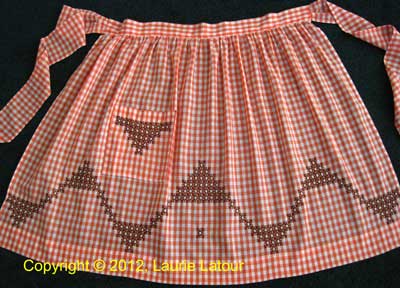
When my grandmother taught me to embroider as a child, I loved to stitch with variegated floss. What fun to watch the colors unfold as you stitch! I still love it. Apparently the maker of this apron thought so too. Just a single row of lace stitch along the waist, pocket and hem splashes a lot of color across the apron.
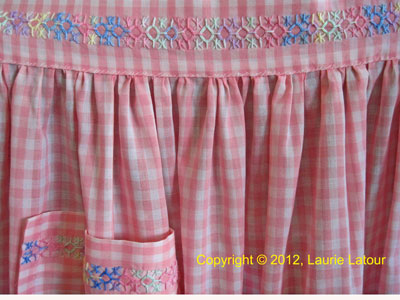
One rainy afternoon, a little stitch play, as Mary so aptly calls it, led to a pretty little bookmark I stitched with one ply of Caron Watercolors thread. Lace stitch is a nice filling stitch in any gingham project, and I especially like the look variegated thread gives it here.

You can weave around the white checks in the fabric, or why not weave around the dark squares? That’s exactly what you do in Reverse Lace Stitch. I tried to create a bit of drama on the bodice of this apron I stitched with #5 pearl cotton. Rayon floss highlights the center of the snowflakes and also helps to anchor them in the large 1/3” checks on this homespun.
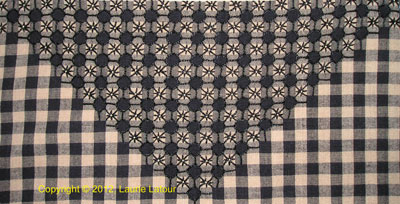
So far, the needle weaving we’ve seen has been worked in circles, but why not try other shapes? On this black gingham apron, the needle worker wove around the running stitches and under the “feet” of the adjacent snowflakes to create squares rather than circles.
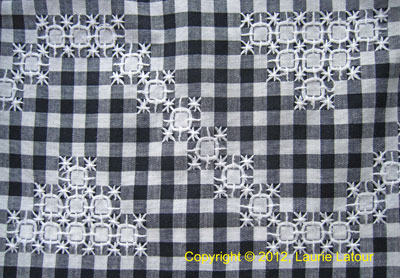
It can be difficult to avoid snagging other parts of the snowflakes when you weave under them with your needle. Those double cross stitches really give a nice lacy look but there are other, simpler ways to weave a square stitch.
You can weave the squares under the ends of cross stitches…
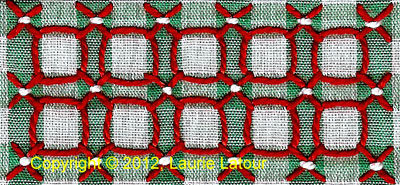
Or simply stitch rows of half cross stitches and weave under those. You could fill the white squares with snowflakes to create a totally different look, or leave it plain as I have here. It’s really up to you!
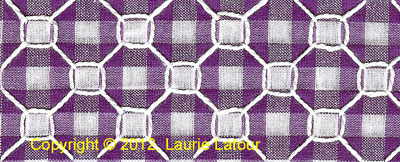
I don’t know about you, but I really enjoy the freedom I have to experiment and create something pleasing to my eye. With gingham embroidery, there is a myriad of possibilities without the fear of spoiling expensive materials – a real “plus” that appeals to my right brain need to play!
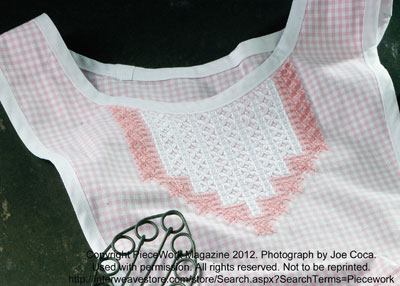
I saved the best for last! Designer and needle worker, Mary Polityka Bush, took gingham lace stitching to new heights in this exquisite apron featured in the May-June 2012 issue of Piecework magazine. Mary worked columns of square lace stitch between oval “leaflets,” all woven under the corners of cross stitches to create a delicate bodice on this stunning apron!
Gingham gets all dressed up in the delicate look of this combination of lace stitches. You’ll find complete directions for this apron in the magazine.
I hope you’ll try your own hand at gingham lace stitch.
Thanks, Laurie!
Gingham embroidery is a great technique to use for teaching children to embroider, too. With a clear grid already mapped out for you on the fabric (thanks to the gingham checks), and with plain thread and a needle, a young child (I’ve taught the technique to kids 6 years and older) can pick up on this stitching pretty quickly. You can find various articles on gingham embroidery here on Needle ‘n Thread, including this tutorial on drawn thread embroidery on gingham. Just type “chicken scratch” or “gingham embroidery” in the search bar on the left column, and all the articles will show up!







Dear Laurie
Thanks for your post. Interesting stitching, a beautiful technique and so diverse, I love the lace work around the squares of the gingham design.
Regards Anita Simmance
Thank Mary for this article about Gingham stitching. I haven’t done this Chicken Scratch embroidery in many years. Your article sure brought back memories.
Thank you, Anita and Esther; I’m glad you enjoyed the article! I only scratched the surface. I have two beautiful tablecloths from the Highlands of Scotland with Lace Stitch worked all the way around them – gorgeous! And I have seen examples online from Italy, France and Russia. Some of the aprons in my ebooks are from Australia ( kangaroos and kookaburras!), Canada and all over the US. It’s nice to see women the world over enjoy this needle craft. As Mary said, it’s great to teach children, and also easier for seniors whose vision and hands make it difficult to work on fine, tiny work.
Happy Stitching!
Laurie
Beautiful work! I must try my hand at this sometime.
Thank you for the trip down memory lane! My grandma made dozens of these aprons. She called it “Tenerife”. What a fun article! I may just have to try some of these myself!!
Carole, I hope you or someone in your family still has some of your grandma’s aprons! What treasures! The Teneriffe motifs used in Gingham Embroidery are not actually Teneriffe Lace, but woven medallions similar to those used in the lace making but applied to gingham. I have a section on Teneriffe in both of my new Gingham Inspirations ebooks with various examples.
I also posted a few photos of this technique back in June last year. You can find them in the Gallery section. Go to page 5 and just scroll to June 21. Anita posted a lovely example she had done on July 31.
Laurie
I am TOTALLY enamored of this technique. It is one of my favorites and I practice it alot! Thanks for the photos!
Another great example of simple materials and techniques giving wonderful results.
Somewhere (Piecework? internet?) I saw a sampler done so that it shaded from almost all white to almost all the other color simply as a result of the choices of thread color and which blocks were stitched on.
Gail, that sounds gorgeous. I’ve been looking at quilt books, and especially Sunshine and Shadow blocks and thinking of incorporating the very shading you described into a project. Maybe a wall hanging… hmmm, not sure yet.
Women for over a century have come up with some incredible designs. While they only hung in the “gallery” of their home, I have tried with my Gingham Inspirations ebooks, to give these women and their work a wider audience. Thy deserve to be seen and enjoyed!
If you ever see that photo again, please post something and let us know!
Laurie
Holy crow! I have not seen this before, but I LOVE it! The combination of gingham and counted stitching is so appealing.
Thanks very much for the post!
G’day Laurie and Mary,
I always find this work really refreshing. It’s ‘honest’, quaint and charming. All an old fashioned country girl should be. Discussion closed!
Thank you for this beaut post.
Cheers, Kath
G’day Kath! You should see the kangaroo apron and a kookaburra apron, both in Gingham Inspirations Book One! It’s so nice to see lovely gingham embroidery from Down Under, and from all over the world, and to know there’s a love for this type of embroidery very alive and well today!
Laurie
Hullo Laurie, I am so pleased to read your article, I have been collecting this type of ‘work’ for quite a while now and have a large collection of all sorts of items. I would be very happy to send you photos of them if you are interested. I live in New Zealand so these are NZ feats of work, although I doubt that changes the outcome of the stitching much. My favourite piece is a huge gingham fabric with a horse filled in on it, looks quite stunning.
Nice to meet someone who loves this embroidery as much as I do.
Regards Anne
Anne, how nice to hear that you collect gingham embroidery in NZ! It always fascinates me how popular this type of embroidery is the world over! I’d love to see some photos. Please e-mail me first, at GinghamABC@gmail.com
Can you post a couple of photos in the Gallery of Mary’s Ask & Share Section? I’m sure others would enjoy seeing them, too, and that horse sounds incredible!
Blessings!
Laurie
I’ve never done chicken scratch although my mom did quite a lot of it. It’s nice to see it make a comeback. Lovely work, Mary.
Thank you soooo much for this post. I love the look of Chickenscratch yet so few people know what I’m talking about when I mention it.
Gorgeous pics,I’m inspired to make an Apron now.
Este bordado aca en Colombia se le llama BORDADO ESPAÑOL,es muy bonito y tiene muchas aplicaciones en lenceria y otras prendas decorativas gracias.
Muchas gracias, Maria! The gingham embroidery in Columbia is so colorful; I love it! I love to see the different ways needle workers in other countries do this type of embroidery. Muy muy bonito! Me gusta!
Laurie
Sou carioca do Rio de Janeiro, Brasil e nunca vi esse tipo de bordado ser feito aqui. Estamos sempre correndo muito, pouco tempo para sentar e ciar coisas à mão, interessantes e criativas como esse bordado. Conhecemos do jeito tradicional, só cruzando as linhas, mas assim com esse contorno em volta do quadradinho, nunca vi! Adorei…ficou com efeito fantástico!
Não falo ingles, entendi um pouquinho do que está escrito, mas fiquei curiosa de como fazem esse círculo em volta de cada quadrado. Parabéns!
I have been searching for the type of embroidery I was introduced to back in the 1980’s through New York State Home Bureau. I saw the usual name on gingham is called Chicken Scratch but have you ever heard of Tenerif Embroidery? When researching it today, it looks more complicated than what we learned back then. Wondering what you may know.
Thanks
Yes, Marlene, Teneriffe medallions are used in Gingham Embroidery or what people sometimes call Chicken Scratch. I just posted some on my Facebook page, which is public, at
https://www.facebook.com/laurie.latour.3
I have a section on Teneriffe motifs in 2 of my ebooks, “Gingham Inspirations, Book One and Book Two” available at:https://marmeedear.com/collections/gingham-embroidery
Laurie/Mary,
I am teaching my three little granddaughters to embroider, using chicken scratch as the introduction. I have looked all over the web to find even an ebook of Laurie’s instructions, to no avail. Could you help? I would gladly purchase a copy.
Hi, Celeste – I don’t know if Laurie is still selling that book online. I have a few tutorials here on Needle ‘n Thread for chicken scratch. You can find them here: https://needlenthread.wpengine.com/2014/04/chicken-scratch-gingham-embroidery-index.html
Where can I find instructions for how to create chicken scratch embroidery stitches?
Hi, Carol – did you try the search function on the website? It would have brought you to this index of articles:
https://needlenthread.wpengine.com/2014/04/chicken-scratch-gingham-embroidery-index.html
Hi Mary-
Do you know of any historical books on the chicken scratch embroidery? I’m looking to learn more about the origin.
Thanks
Kate
No, I sure don’t, Kate. But maybe someone else will chime in with a resource for you.